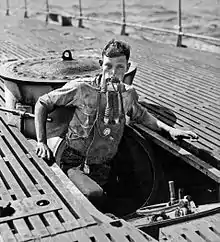Momsen lung
The Momsen lung was a primitive underwater rebreather used before and during World War II by American submariners as emergency escape gear. It was invented by Charles Momsen (nicknamed "Swede").[1] Submariners trained with this apparatus in an 80 ft (24 m) deep Escape Training Tank at New London, Mare Island,[2] or Pearl Harbor. It was introduced as standard equipment on Porpoise (P)-class and Salmon-class boats.[3]


The device recycled the breathing gas by using a counterlung containing soda lime to remove the carbon dioxide. The lung was initially filled with oxygen and connected to a mouthpiece by twin hoses containing one-way valves, one for breathing in and the other for breathing out.[4]
The only emergency use of the Momsen lung was during the escape from USS Tang on October 25, 1944.[5] Thirteen men (of thirty survivors) left the forward escape trunk:[6] five were picked up by the Japanese; three more reached the surface "but were unable to hang on or breathe and floated off and drowned"; the fate of the other five is unknown.[7][8][9] Not all the escapees from the trunk used the Momsen lung. An officer had his mouthpiece knocked out shortly after leaving the submarine.[10] One of the trunk ascents was made without a Momsen lung.[11] Many were unable to leave the trunk or discouraged from attempting an escape.[12] Most of the crew perished.
The Momsen lung was replaced by the Steinke hood beginning in 1962. The British Royal Navy used the similar Davis Submerged Escape Apparatus, but it was clumsy to use. They adopted the practice of "blow and go" in which the sailor would exhale before ascent to avoid air over-expanding the lungs, which could cause them to rupture. This has since been found to be higher risk than a constant relaxed exhalation during ascent. Walter F. Schlech, Jr. and others examined submerged escape without breathing devices and discovered that ascent was possible from as deep as 300 ft (91 m). One writer suggested that "the Momsen Lung concept may have killed far more submariners than it rescued".[13]
See also
- Steinke hood – Submarine escape breathing apperatus
- Submarine Escape Immersion Equipment – Whole-body exposure suit that allows submariners to escape from a sunken submarine
- Escape set – Self contained breathing apparatus providing gas to escape from a hazardous environment
References
- "US People--Momsen, Charles B." Archived from the original on 2000-01-23.
- Toll, Ian, The Conquering Tide: War in the Pacific Islands, 1942-1944 (New York: Norton, 2015), p. 65.
- Blair, Clay, Jr. Silent Victory (Philadelphia: Lippincott, 1975), p. 65.
- Office of Naval Research. "Swede Momsen: Diving & Rescue – Momsen Lung". Archived from the original on 2007-08-07. Retrieved 2008-06-16.
- Blair, pp.767-8.
- Blair, p.768.
- O'Kane, Richard H. (1989) [1977], Clear the Bridge!, Presidio Press p. 445, quoting Report of War Patrol Number 5 and Report of the Loss of the U.S.S. TANG (SS306).
- It's unclear how many made it to the surface alive. Blair, pp. 767–768.
- Recent text about the Tang (ca 2000?) identified CTM reaching the surface but not being able to breathe. There is also the possibility that the first groups to leave the escape trunk had not removed a clip from the Momsen lung.
- U.S. Naval Submarine School (1966), Submarine Casualties Booklet, New London, CT: U.S. Naval Submarine Base, archived from the original on 2011-07-27, retrieved 2009-09-08
{{citation}}: CS1 maint: unfit URL (link) p=G-42 - U.S. Naval Submarine School (1966, p. G-43)
- U.S. Naval Submarine School (1966, p. G-41)
- Blair, p. 768fn.
External links
- US Navy History of the Momsen Lung
- "Submarine Safety Device Proven." Popular Science Monthly, September 1929, pp. 30–31.
- The short film Submarine Escape - US Navy Training Film - 1953 is available for free download at the Internet Archive.
Underwater diving | |||||||||||||||||||||||||||||||||||||
|---|---|---|---|---|---|---|---|---|---|---|---|---|---|---|---|---|---|---|---|---|---|---|---|---|---|---|---|---|---|---|---|---|---|---|---|---|---|
| |||||||||||||||||||||||||||||||||||||
| |||||||||||||||||||||||||||||||||||||
| |||||||||||||||||||||||||||||||||||||
| |||||||||||||||||||||||||||||||||||||
| |||||||||||||||||||||||||||||||||||||
| |||||||||||||||||||||||||||||||||||||
| |||||||||||||||||||||||||||||||||||||
| |||||||||||||||||||||||||||||||||||||
| |||||||||||||||||||||||||||||||||||||
| |||||||||||||||||||||||||||||||||||||
| |||||||||||||||||||||||||||||||||||||
| |||||||||||||||||||||||||||||||||||||
| |||||||||||||||||||||||||||||||||||||
| |||||||||||||||||||||||||||||||||||||
| |||||||||||||||||||||||||||||||||||||
| |||||||||||||||||||||||||||||||||||||
| |||||||||||||||||||||||||||||||||||||